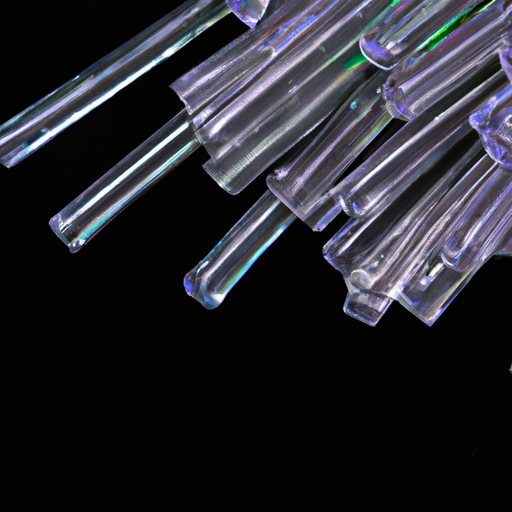Title: The Mainstream Crystal Tube Production Process: A Comprehensive Overview

1. Crystal Tube Materials (200 words) Crystal tubes are typically made from high-quality materials such as quartz, borosilicate glass, or fused silica. Quartz is the most commonly used material due to its excellent transparency, high thermal stability, and low coefficient of thermal expansion. Borosilicate glass is preferred for its superior chemical resistance, while fused silica offers exceptional purity and low impurity content.
2. Tube Formation (200 words) The first step in crystal tube production involves forming the raw material into a tube shape. This can be achieved through various methods, including extrusion, drawing, or molding. Extrusion is commonly used for quartz tubes, where the material is heated and forced through a die to obtain the desired tube shape. Drawing involves pulling a heated glass rod to form a tube, while molding utilizes a pre-formed mold to shape the material.
3. Tube Cleaning and Polishing (200 words) Once the tube is formed, it undergoes a thorough cleaning process to remove any impurities or contaminants. This is crucial to ensure the final product's optical clarity and performance. Cleaning methods may include ultrasonic cleaning, acid washing, or high-temperature annealing. After cleaning, the tube is polished to achieve a smooth and uniform surface, enhancing its optical properties.
4. Tube Annealing (200 words) Annealing is a critical step in the crystal tube production process, as it helps relieve internal stresses and improves the material's thermal stability. The tube is heated to a specific temperature and then slowly cooled to ensure uniformity and prevent cracking. This process also enhances the tube's mechanical strength and resistance to thermal shock.
5. Tube Cutting and Shaping (200 words) Once the tube is annealed, it is cut into desired lengths using precision cutting tools. The cut tubes are then shaped according to specific requirements, such as flaring, tapering, or threading. These shaping processes are crucial for achieving the desired functionality and compatibility with other components.
6. Tube Surface Treatment (200 words) To further enhance the tube's performance and durability, various surface treatments can be applied. These treatments may include coating the tube with a protective layer, such as silicon dioxide or aluminum oxide, to improve its resistance to chemicals or abrasion. Additionally, anti-reflective coatings can be applied to minimize light reflection and maximize optical transmission.
7. Quality Control and Testing (200 words) Throughout the crystal tube production process, rigorous quality control measures are implemented to ensure the final product meets the required specifications. This includes dimensional checks, optical testing, and thermal stability assessments. Advanced techniques such as interferometry, spectrophotometry, and thermal cycling are employed to verify the tube's quality and performance.
Conclusion (100 words) The mainstream crystal tube production process involves several crucial steps, from material selection to quality control. Understanding this process provides valuable insights into the complexity and precision required to manufacture these essential components. As technology continues to advance, crystal tube production techniques are likely to evolve, leading to further improvements in performance, durability, and cost-effectiveness.
Title: The Mainstream Crystal Tube Production Process: A Comprehensive Overview

1. Crystal Tube Materials (200 words) Crystal tubes are typically made from high-quality materials such as quartz, borosilicate glass, or fused silica. Quartz is the most commonly used material due to its excellent transparency, high thermal stability, and low coefficient of thermal expansion. Borosilicate glass is preferred for its superior chemical resistance, while fused silica offers exceptional purity and low impurity content.
2. Tube Formation (200 words) The first step in crystal tube production involves forming the raw material into a tube shape. This can be achieved through various methods, including extrusion, drawing, or molding. Extrusion is commonly used for quartz tubes, where the material is heated and forced through a die to obtain the desired tube shape. Drawing involves pulling a heated glass rod to form a tube, while molding utilizes a pre-formed mold to shape the material.
3. Tube Cleaning and Polishing (200 words) Once the tube is formed, it undergoes a thorough cleaning process to remove any impurities or contaminants. This is crucial to ensure the final product's optical clarity and performance. Cleaning methods may include ultrasonic cleaning, acid washing, or high-temperature annealing. After cleaning, the tube is polished to achieve a smooth and uniform surface, enhancing its optical properties.
4. Tube Annealing (200 words) Annealing is a critical step in the crystal tube production process, as it helps relieve internal stresses and improves the material's thermal stability. The tube is heated to a specific temperature and then slowly cooled to ensure uniformity and prevent cracking. This process also enhances the tube's mechanical strength and resistance to thermal shock.
5. Tube Cutting and Shaping (200 words) Once the tube is annealed, it is cut into desired lengths using precision cutting tools. The cut tubes are then shaped according to specific requirements, such as flaring, tapering, or threading. These shaping processes are crucial for achieving the desired functionality and compatibility with other components.
6. Tube Surface Treatment (200 words) To further enhance the tube's performance and durability, various surface treatments can be applied. These treatments may include coating the tube with a protective layer, such as silicon dioxide or aluminum oxide, to improve its resistance to chemicals or abrasion. Additionally, anti-reflective coatings can be applied to minimize light reflection and maximize optical transmission.
7. Quality Control and Testing (200 words) Throughout the crystal tube production process, rigorous quality control measures are implemented to ensure the final product meets the required specifications. This includes dimensional checks, optical testing, and thermal stability assessments. Advanced techniques such as interferometry, spectrophotometry, and thermal cycling are employed to verify the tube's quality and performance.
Conclusion (100 words) The mainstream crystal tube production process involves several crucial steps, from material selection to quality control. Understanding this process provides valuable insights into the complexity and precision required to manufacture these essential components. As technology continues to advance, crystal tube production techniques are likely to evolve, leading to further improvements in performance, durability, and cost-effectiveness.